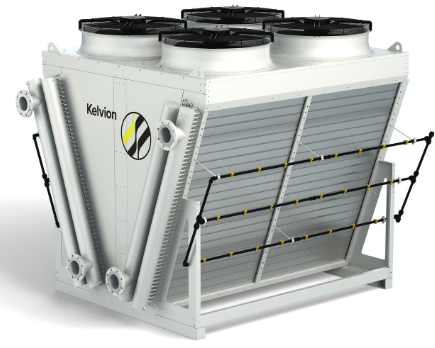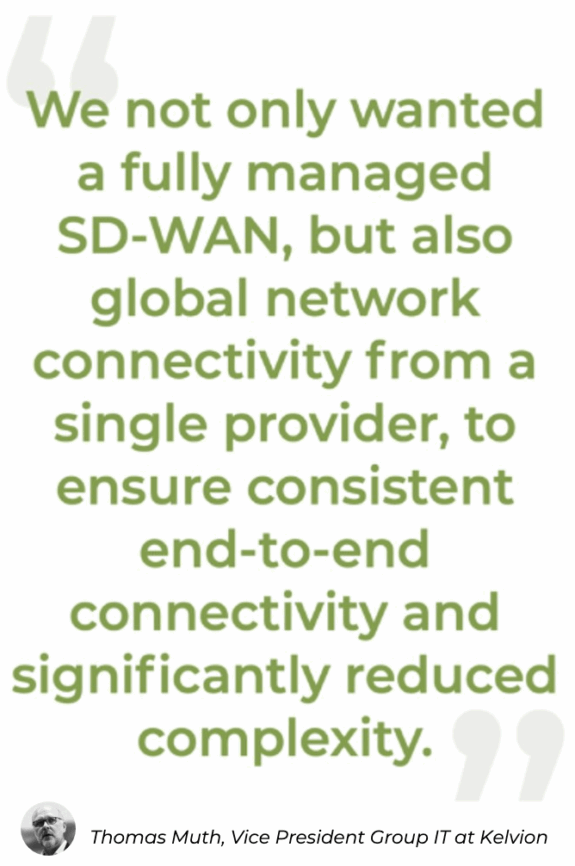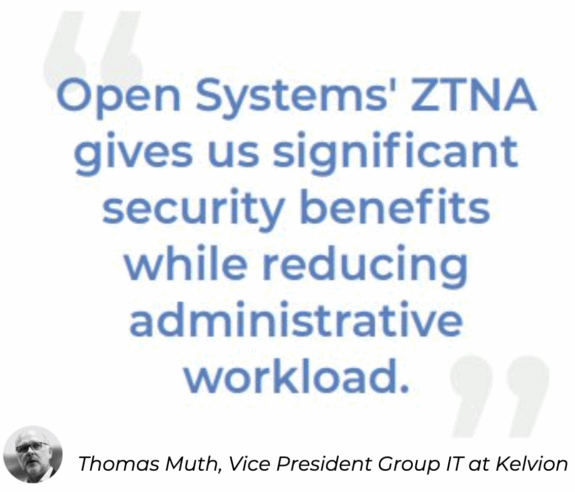
Kelvion
Running a 72-site network with just 2 employees
The Challenge
As a growing company, Kelvion needed a scalable, secure, and globally available WAN – with high performance, low complexity, and reliable operations.
The Solution
A fully managed SD-WAN from Open Systems, providing seamless global connectivity, security, and 24x7 expert support – all from a single provider.
The Results
A rapid rollout to 90 sites worldwide in just six months. High security, top-tier global connectivity, and significant relief for the IT team through managed services.
Kelvion is a global specialist in heat exchange solutions with around 6,000 employees at 72 sites worldwide. As the company grew globally, its fragmented and partly unreliable network infrastructure could no longer meet modern demands. To support secure, reliable global operations and future digital initiatives, Kelvion needed a scalable, high-performance WAN with minimal complexity – and a partner to deliver it seamlessly across all locations.

Employees
managing network of 72 global sites
Month
global rollout of SD-WAN deployed worldwide in record time
Managed SD-WAN
fully operated by Open Systems with 24x7 support
Global Partner
for SD-WAN and connectivity
The Interview
We recently sat down with Thomas Muth, Vice President Group IT at Kelvion, to discuss the company’s past challenges and goals, and how Open Systems provided a comprehensive solution.
What challenge were you looking to address together with Open Systems?
When I joined Kelvion in 2018, I encountered a very heterogeneous and outdated network infrastructure. The existing WAN was largely based on old MPLS lines with insufficient bandwidth – partly managed, partly unmanaged, and often poorly administered. For example, there was only one central VPN connection with 100 megabytes for the entire group.
Given Kelvion’s already foreseeable global growth at the time, we decided to fundamentally modernize our global WAN. The initial challenge was to develop a future-proof architectural concept. It quickly became clear to me that we needed a partner who could offer maximum flexibility, leverage innovative solutions, and deliver them globally, consistently, and reliably – with the right team to support it.
The heterogeneous and partly unreliable infrastructure meant we needed a solution that could ensure secure and high-performance site connectivity even under such conditions. A global, resilient connection over the public internet became a key requirement.
 To find the right partner for our network transformation, we issued a comprehensive tender. A central requirement was not only to implement a fully managed SD-WAN, but also to source all global network connections from a single provider. This was crucial to ensure consistent, high-performance end-to-end connectivity and to reduce complexity in both operations and support. Ultimately, only Open Systems was able to provide both components – SD-WAN and global connectivity – as an integrated, one-stop solution. After a thorough market analysis, we deliberately chose Open Systems’ offering: a globally standardized, modern SD-WAN including network connectivity, fully operated by the partner. The decision was driven by the compelling overall package of high quality, technical flexibility, and attractive cost-efficiency.
To find the right partner for our network transformation, we issued a comprehensive tender. A central requirement was not only to implement a fully managed SD-WAN, but also to source all global network connections from a single provider. This was crucial to ensure consistent, high-performance end-to-end connectivity and to reduce complexity in both operations and support. Ultimately, only Open Systems was able to provide both components – SD-WAN and global connectivity – as an integrated, one-stop solution. After a thorough market analysis, we deliberately chose Open Systems’ offering: a globally standardized, modern SD-WAN including network connectivity, fully operated by the partner. The decision was driven by the compelling overall package of high quality, technical flexibility, and attractive cost-efficiency.
Together, we launched an international rollout project and implemented a fully managed SD-WAN at what were then 90 sites worldwide – in just six months. Open Systems provided the security gateways, which we had installed on-site. In parallel, Open Systems handled the global procurement and provisioning of the required lines – a logistically and technically very demanding task.
During the project, it became clear to me that Open Systems impressed not only with their technology but especially with the consistently high quality of execution.
About a year after the SD-WAN rollout, we decided to expand our VPN capacities – partly because more and more employees were working flexibly and remotely. We quickly ordered a large number of additional VPN access points. The entire process ran smoothly, and the solution has remained stable and high-performing to this day. That, too, is a clear sign of quality and scalability for me.
What specific goals did you have in terms of creating a leaner IT organization?
I come from an outsourcing background, and for me, it’s a fundamental principle to delegate tasks to specialized and, where possible, consolidated providers who can perform them better, more efficiently, and with higher quality than we could do ourselves. I’m convinced not everything needs to be done in-house – especially when it’s neither economically nor qualitatively sensible.
Running a network internally would require at least five to six specialists solely for operational tasks – and that’s without 24×7 coverage. Realistically, it would take closer to 14 employees working in shifts to match the level of quality and availability that Open Systems provides with its global 24×7 support. That would be neither economically viable nor strategically justifiable.
Open Systems operates significantly more networks on a daily basis than we do – with high expertise and a strong focus on quality and innovation. I deliberately use this service efficiently: we have a dedicated service manager who works closely with Open Systems to continuously develop our network – both technologically and in terms of security. This includes firewalls, security concepts, infrastructure – the entire WAN landscape.
When we talk about a lean organization, this is exactly what it means: leveraging high-quality external services at a competitive total cost of ownership (TCO), rather than building functions internally that others can deliver better and at higher scale. That’s precisely why our decision to implement a fully managed SD-WAN was a strategic one – not just a technical one.
What specific improvements have you seen through the collaboration?
 It’s hard to quantify exact time or cost savings, as we don’t systematically measure WAN speed or individual employee productivity. So I would answer the question differently: Since we began working with Open Systems, we haven’t experienced a single outage caused by their operations – and for me, that’s a key indicator of quality.
It’s hard to quantify exact time or cost savings, as we don’t systematically measure WAN speed or individual employee productivity. So I would answer the question differently: Since we began working with Open Systems, we haven’t experienced a single outage caused by their operations – and for me, that’s a key indicator of quality.
Many companies experience WAN providers causing outages two or three times a year – often due to faulty updates – that lead to real production losses. Production lines halt, employees can’t work, and critical business processes are disrupted. We’ve never experienced such incidents with Open Systems – not even during scheduled updates, which are carried out regularly on the security gateways or central components.
We’ve also seen major benefits in terms of security. If we ran the WAN ourselves, we would be responsible for all local components – especially switches and firewalls. With 72 sites, we’re talking about at least 72 switches. Each one would need to be updated regularly with the latest firmware. We’d also be responsible for managing and maintaining firewall rules, whitelists, blacklists, and much more.
Today, Open Systems takes care of all of that for us – fully managed, using best-practice methods and in line with current security standards. This significantly reduces the workload for our internal team while ensuring a consistently high level of security across our global network.
How has the collaboration affected your internal team structure or skill requirements?
Thanks to the collaboration with Open Systems, we haven’t had to hire additional network staff in the past four years. We currently operate our global network with just one and a half full-time equivalents – one internal employee and one external specialist.
This is possible because one central contact person is enough to coordinate with Open Systems – through regular technical reviews, update coordination, and strategic network development.
Thanks to the partnership with Open Systems, we’ve not only avoided building a larger internal network team but also benefit from a professionally managed, highly available, and state-of-the-art network. The collaboration enables us to operate a global SD-WAN efficiently, securely, and scalable – with minimal staffing.
You also use Open Systems’ ZTNA. What has your experience been?
For maintenance purposes, it’s occasionally necessary to grant external partners access to our systems. In the past, this was done via traditional VPN, which meant external service providers potentially had access to the entire network.
With Open Systems’ ZTNA (Zero Trust Network Access), we can now manage access in a far more granular, secure, and compliant way. External partners only get access to the specific applications or systems they actually need – nothing more.
This represents a significant gain in security for us while also reducing administrative overhead. ZTNA enables much more precise access control at the application level, without compromising the flexibility external service providers need.
How do you plan to further develop your IT organization?
 I’m developing our IT organization in step with the growth of the Kelvion Group. Over the past three years, we’ve experienced significant growth – both in terms of staffing and technology – with a high-performing IT function playing a strategically vital role as a partner for the business. In addition to continually expanding our team, we’re actively driving digitalization – particularly in areas such as IoT, the use of AI technologies, process management, and the development of KPI systems in production environments.
I’m developing our IT organization in step with the growth of the Kelvion Group. Over the past three years, we’ve experienced significant growth – both in terms of staffing and technology – with a high-performing IT function playing a strategically vital role as a partner for the business. In addition to continually expanding our team, we’re actively driving digitalization – particularly in areas such as IoT, the use of AI technologies, process management, and the development of KPI systems in production environments.
Our IT department is growing not only through internal hires but also through targeted partnerships – with companies like Open Systems and other specialized service providers. This hybrid growth strategy allows us to respond to new requirements flexibly and as needed.
A key success factor for us is growth flexibility: we consciously work with external experts to bring in temporary specialized knowledge.
We’re not aiming to significantly expand our IT department in the coming years. Instead, we plan to grow in a targeted, topic-driven way, always closely aligned with the group’s strategic priorities – whether through internal experts or skilled partners.
What advice would you give to other companies facing similar challenges?
Many companies still rely on outdated technology. A major issue often lies in the lack of transparency regarding their own IT infrastructure – especially when it comes to the systems in use and how they interact. To use modern technologies, companies first need clarity about their existing IT landscape.
 Why don’t companies use the latest technologies? In my view, there are two main reasons: first, the question of cost – modern technologies require upfront investment. Second, the fear of the effort involved in making changes. Migration to modern solutions is often perceived as too complex or too risky.
Why don’t companies use the latest technologies? In my view, there are two main reasons: first, the question of cost – modern technologies require upfront investment. Second, the fear of the effort involved in making changes. Migration to modern solutions is often perceived as too complex or too risky.
However, I strongly advise every company to actively engage with new technologies – especially in the context of cybersecurity. For globally operating companies, it’s essential that their WAN – the backbone of IT – offers a high level of security. That means: it must be continuously updated, professionally monitored, and actively managed by true experts who keep an eye on it around the clock.
I recommend that all IT leaders ask themselves honestly whether that standard is being met in their own organization. If not, they should actively seek out partners who can implement such a project with minimal internal effort. Because in many cases, it’s not the technology that holds companies back – it’s the fear of a global rollout.
I’ve seen many WAN projects stretch out over years and ultimately fail to deliver reliable performance. The most common reasons: choosing the wrong partner or the wrong technology. That’s why it’s critical to rely on experience and choose a partner like Open Systems – one that has a proven track record of successfully delivering global projects.
One thing is certain: companies that don’t take this step will, sooner or later, face serious problems with IT security.
Is there any aspect of working with Open Systems you’d particularly highlight?
When I think of Open Systems, the first thing that comes to mind is the people we work with. A great example is our dedicated Technical Account Manager, who has been our key contact for years. From day one, I could rely on him. I know he’d call me immediately if something went wrong – and just as naturally, I pick up the phone myself whenever I need to discuss something.
And that goes beyond just him. There are many people at all levels within Open Systems I can always count on. It’s a great feeling to have a partner you’ve built trust with over the years – one you know will reach out immediately when something critical happens. And in return, I know I can always call someone – whether it’s a technical question, a new idea, or a specific need, like regarding a firewall or network connection – and I’ll always get reliable support.
This personal connection, open communication, and strong sense of responsibility – that’s what comes to mind when I think of Open Systems. Their team truly takes responsibility for keeping our SD-WAN stable. I can rely on that commitment.
A defining example was the beginning of the COVID pandemic: within a very short time, we activated VPN licenses together to enable up to 5,000 employees to securely access the corporate network from their home offices – just two weeks before the first lockdown. Back then, it wasn’t even clear if it would happen – but we had good instincts. And when things got serious, we were fully prepared. Thanks to the fast implementation with Open Systems, Kelvion’s operations continued seamlessly.

Leave Complexity
Behind
To learn how Open Systems SASE Experience can benefit your organization, talk to a specialist today.
Contact Us



